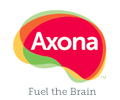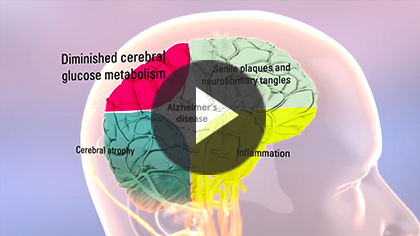What causes Alzheimer’s disease?
Scientists are trying to unravel the mysteries of Alzheimer’s disease1,2
While the cause of Alzheimer’s disease is not entirely known, scientists think that it develops because of a complex series of events in the brain that occur over a long period of time. They’re also looking at how the brain changes with age to try and find clues as to how the disease begins.
It’s clear now that Alzheimer’s isn’t caused by one factor alone. For most people with the disease, a combination of age and genetics, lifestyle, and environmental factors seems to contribute. For a small number of people with Alzheimer’s (less than 5%), specific genes are likely to be the main cause.
A look inside the brains of people with Alzheimer’s disease2,3
Scientists aren’t certain what causes Alzheimer’s disease, but they are starting to understand how it affects the brain. Alzheimer’s disease damages and kills brain cells, or neurons. As the disease progresses, more neurons die, making it more difficult for the brain to function.
When scientists look at the Alzheimer’s brain under a microscope, they can see two abnormal structures (called plaques and tangles). They believe these structures are associated with the disease process and may contribute to the death of neurons.
- Amyloid plaques – Deposits of a protein (called beta-amyloid) that build up around brain cells
- Neurofibrillary tangles – Abnormal collections of a protein (called tau) that build up inside neurons
Using brain scanning techniques, such as positron emission tomography (PET), researchers have discovered something else in the brains of people with Alzheimer’s:

Normal cerebral
glucose metabolism
Alzheimer’s disease brain

Diminished cerebral
glucose metabolism
Image source: Small GW, Ercoli LM, Silverman DHS, et al. Cerebral metabolic and cognitive decline in persons at genetic risk for Alzheimer's disease. Proc Natl Acad Sci USA. 2000;97(11):6037-6042. Copyright 2013 National Academy of Sciences, U.S.A.
- Diminished cerebral glucose metabolism – or glucose hypometabolism, means that neurons have difficulty producing the energy they need to function. Neurons normally use glucose (a type of sugar) as the primary fuel source to power the brain’s daily activities. In Alzheimer’s disease, scientists have discovered that the engines inside neurons malfunction, so that even if there is enough glucose in the body, the brain cannot use it properly. This most often occurs in the areas of the brain involved in memory and cognition, and it can begin years, sometimes decades, before any symptoms of the disease appear
The good news is that there is now a way to address diminished cerebral glucose metabolism.



